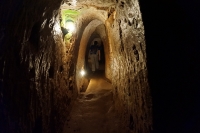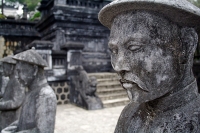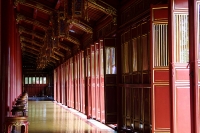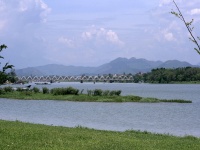
Under the Geneva Accords of 1954, Vietnam was split into North and South along the 17th parallel. The Ben Hai River was selected as the temporary demarcation line. A three-mile (5km) strip of no-man's land on either side of the border was known as the DMZ or Demilitarised Zone.It was bombed into a desolate wasteland, riddled with land mines and surrounded by barbed wire during the war. The area surrounding the DMZ and the land in between was the worst affected, and the amount of explosives, napalm and chemicals used, including Agent Orange, has left the once heavily forested land with stunted growth and infertile soil. Historical sites and landmarks include the Hien Luong Bridge spanning the river, entry to the Ho Chi Minh Trail that bypassed the border, the American firebase at Con Thien, U.S Marine base at Khe Sanh, and the Truong Son War Martyr Cemetery dedicated to the thousands who died on the Ho Chi Minh Trail. A guided tour is strongly recommended as there are no signs and the area still contains unexploded landmines.Vinh Moc is known for the extraordinary complex of tunnels constructed by the villagers as an underground village in which to shelter from American bombardments. Faced with the total destruction of their village in 1965, they dug an underground network consisting of three layers starting at a depth of 33ft (10m) with room for 300 people, including wells, a school, clinics, storerooms, observation posts, ventilation shafts and a maternity room where 17 babies were delivered during the war. A section has been restored and is open to visitors and there is a small museum at the entrance. To fully appreciate the history of the site, its best to hire a guide.
Address : Vinh Thach, Vinh Linh, Quang Tri
Transport : It is best to organise transport through a tour operator.
Admission : Dependent on a tour operator.

South of Hué are eight splendid royal tombs of the Nguyen emperors, situated among the hills on the banks of the Perfume River. Often designed while the emperor was still alive, each mausoleum was built to serve as a palace for the afterlife. In this vein the tombs were built as vast complexes, each with traditional functions.These complexes include paved courtyards lined with mandarin statues, a stone stele inscribed with details of his reign, a main temple dedicated to the worship of the deceased and containing personal effects, and the tomb itself. Surrounding the complex were artificial ponds in a garden-like setting. The Tomb of Tu Dac, with its lotus-filled lake and central pavilion, the remarkable mosaics of Minh Mang's Tomb, and the simple and serene Tomb of Khai Dinh are the most interesting.
Address : Thien Tho Mount, four to ten miles (7-16km) south of Hué
Transport : Take a Perfume River boat trip and hire a motorbike taxi waiting at the riverbank to go between the sites, or hire a car, bicycle or motorbike to get to the tombs. The cheapest options are to hire a motorcycle or rickshaw guide.
Opening times : Daily from 6.30am-5.30pm April to September, 7am-5pm October to March.
Admission : Depending on which tomb you enter, tickets range from 40,000 VND to 150,000 VND per place. Alternatively, look for a blanket ticket for around 360,000 VND.

Constructed by Emperor Gia Long in 1804 for the private use of the emperor and his household, the enormous moated Citadel is comprised of three separate walled enclosures. The outer citadel, surrounded by a six mile (10km) perimeter wall, punctuated by 10 gates, frames the Imperial Enclosure used for official business.At the very centre is the Forbidden Purple City, the restricted residence of the emperor and his concubines. This once magnificent Imperial City originally included many magnificent features, with tombs, pagodas and temples, lakes and lavishly gilded pavilions.Today remnants of the palaces contain ornate ceremonial halls and throne rooms, mosaics adorn roofs and pillars, and beautiful landscaped gardens surround the remaining buildings. Sadly much was destroyed during the Vietnamese War, and a fire further damaged the Forbidden Purple City, but it is still possible to see evidence of its past glory.The main entrance is through the Ngo Mon Gate (Noon Gate), a stunning example of Nguyen architecture, with separate entrances for the emperor, his mandarins and the royal elephants. A soaring multi-roofed pavilion used for important royal proclamations, sits elegantly on top.
Address : North bank of the Perfume River
Opening times : Daily from 8am-5.30pm, Thursday from 8am-10pm.

A boat trip on the Perfume River is one of the highlights of a visit to Hué and includes stops to visit some of the city's main attractions. Passing other sampans (traditional rowing boats) on their way to the market, houseboats and dragon boats, a typical trip will take visitors to the Thien Mu Pagoda, Hon Chen Temple and the Royal Tombs.The Thien Mu Pagoda is one of the oldest and most attractive religious structures in Vietnam, dating back to 1601. Its most striking feature is the seven-tiered tower, representing the seven steps to enlightenment. Another way to experience the Perfume River is on an evening boat trip hosting a traditional folksong performance. This long-standing tradition goes back to the rule of the emperors when artists would play music and recite poetry from a rowing boat on the river.
Transport : Boat trips up the river and to the Citadel are very popular ways to explore the mausoleums in the area; be prepared to negotiate fees.
Admission : 3 USD for a day trip, not including site entrance fees. Evening performances are 3 USD to 5 USD. Fully organised tours may come to 60 USD.

Travel Guide powered by Word Travels, copyright © 2023 Globe Media Ltd. By its very nature information in this travel guide is subject to change at short notice and travellers are urged to verify information on which they're relying with the relevant authorities. Neither Globe Media Ltd nor Travel Vogue can accept any responsibility for any loss or inconvenience to any person as a result of information contained above.